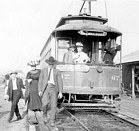|
|
 |
 |
|
Reading Guide |
| 3. |
Segregation
| - | U.S. Supreme Court, Plessy v. Ferguson, 1896, excerpts |
| - | Charles W. Chesnutt, "A Journey Southward," Ch. 5 of The Marrow of Tradition, novel, 1901, excerpts |
| - | Richmond Planet, coverage of streetcar boycott, 1904, excerpts |
|
|
 Florida, 1910 |
Perhaps the single most telling moment of the 1890s for black citizens was the Supreme Court's decision that segregated public facilities did not violate the Constitution. Why a "telling moment?" Because it said to African Americans "you're on your own." The federal government would not enforce integration, just as it would not pass an anti-lynching law or, later, maintain integrated federal workplaces. Thus we first read from the Court's decision—from the majority opinion that segregation does not "[stamp] the colored race with a badge of interiority," and from Justice Harlan's poignant dissent that segregation does, in fact, give "a badge of servitude wholly inconsistent with the civil freedom and the equality before the law" guaranteed by the Constitution.
In the second reading, Charles Chesnutt gives us a view of life after Plessy. On a train journey from New York to North Carolina, a "mulatto" physician is forced to leave the car in which he had begun the journey because it had become a white-only car on arriving in Virginia. The complexity of response and nuance that Chesnutt works into this brief chapter is astounding. The third text is a pair of news articles on the 1904 Baltimore streetcar boycott, which was organized to protest a state law allowing streetcar companies to segregate passengers by race. Like the Montgomery, Alabama, bus boycott of a half century later, this boycott lasted almost a year and nearly bankrupted the streetcar company. Unlike the Montgomery boycott, however, it did not see success. To end the boycott, the Virginia legislature mandated segregated streetcars, and further protest was to wait for a later day. 14 pages.
Discussion questions
- According to the majority in Plessy, why does segregation not violate the Fourteenth Amendment? Why does this argument fail, according to the lone dissenter Justice Harlan?
- How does the application of Plessy in real life affect black and white people, as portrayed in Chesnutt's story? What long-term harm does Chesnutt foresee?
- How did the black leaders in Richmond couch their appeal to white readers? In what ways was their boycott successful?
- In your opinion, why did the black leaders not continue the boycott after the Virginia legislature mandated streetcar segregation?
- Why can African American history of this period be legitimately divided into "before Plessy" and "after Plessy?"
|
» Link |
 |
 |
Topic Framing Questions
| • |
What forms of political action did African Americans initiate? For what goals? |
| • |
How was political action affected by the increase in discrimination and violence during the 1890s? |
| • |
How did black leaders frame their political objectives for their white audience? |
| • |
To what extent did black political action affect the lives of ordinary African Americans? |
|
|
 |
 |
|
 |
